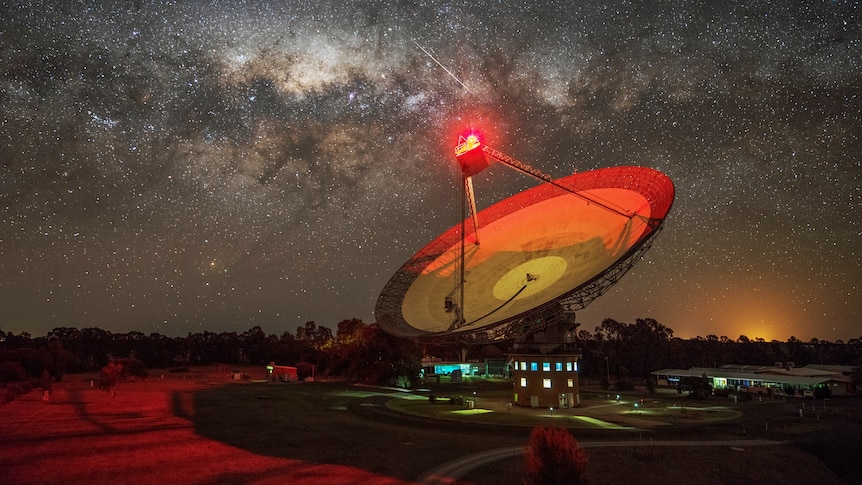Human-made interference, not extraterrestrial technology, is responsible for the first candidate “signal of interest” detected by the project Breakthrough Listen.

CSIRO / A.Cherney
It’s called BLC1, and it’s the closest we’ve ever come to finding intelligent alien life.
In 2019, astronomers discovered a radio signal that appeared to come from Proxima Centauri, the nearest star to the Sun. Though the signal was clearly unnatural in origin, it bore no obvious mark of humanity. The scientists named it Breakthrough Listen Candidate 1, or BLC1, after the state-of-the-art search for extraterrestrial intelligence that made the detection. Until now, no one knew its true nature.
In a pair of articles published in Nature Astronomy earlier this week, members of the Breakthrough Listen team reported that although BLC1 almost perfectly resembles a true alien signal, new tests indicate it is of human origin.
“BLC1 is, in my opinion, the most compelling signal of interest ever,” says Danny Price (International Centre for Radio Astronomy Research), a contributing researcher on both studies. “[It] has almost all the characteristics we expect from a technosignature,” meaning evidence of the use of technology.
That is no mean feat. There are several ways radio searches check whether a signal might truly have come from an alien civilization, and BLC1 is the only one ever that checked all the most important boxes.
From First Contact To None
First, BLC1 is narrow in frequency, a tone purer than any natural process could produce – so it was clearly made by technology. Second, BLC1 was only detected when the telescope was looking at Proxima Centauri. That made it less likely to have been caused by human radio interference.
But what really made BLC1 exciting was that its frequency changed. For a similar reason that an ambulance’s siren sounds higher-pitched when it comes toward you and lower as it moves away, a radio signal from outer space will change frequency depending on the transmitter’s velocity relative to Earth. BLC1’s frequency drifted exactly like it would if it were being emitted by something moving within the Proxima Centauri system, like a satellite or planet.
Put that all together and you get a telltale signal, one that resembles a narrow, intermittent waterfall cascading down your screen. As Price describes it, seeing that signature captured the Breakthrough team’s imaginations.
“It’s the first signal we’ve seen that has warranted serious follow-up,” he adds.

ESO / M. Kornmesser
But when Breakthrough Listen observed Proxima Centauri again in 2020, and yet again exactly two years after the original detection, BLC1 had disappeared.
Something was wrong. Yet there were no tests left in the old playbook. If the team was going to find where BLC1 came from, they had to invent new ways to look for clues.
A Needle In A Haystack
There are no known electronics on Earth that intentionally transmit at BLC1’s frequency, so one of the first places astronomers looked was space. They checked satellites, space probes, and even asteroids, which can reflect radio waves from Earth.
When that search turned up dry, they looked at possible routes around the observatory for anything that could have theoretically produced the interference. Someone strolling around with a device in their pocket, a car on the freeway, a plane on the horizon – any of these might have been able to mimic the drift of the signal. But when the team charted all the potential paths a person or vehicle might have taken nearby, they found that none could explain BLC1.
The team tried a new strategy: they searched for “lookalikes.” If BLC1 is not unique – if it was also detected when the telescope was pointing somewhere else – then it wasn’t ET. Searching all the data they had taken on hundreds of other stars, the team turned up a few dozen signals that drifted exactly like BLC1, though around different frequencies.
"That's when I felt we had enough evidence to conclude that BLC1 was radio interference," Price recalls.
With careful study, the team found that all of these signals could be produced by a single electronic device interfering with itself, producing weak radio waves at a range of frequencies that just barely leaked into the telescope. Price’s best guess is some piece of high-end electronics, tens or hundreds of miles away.
What exactly the device was is beside the point. What matters is that the new tools Breakthrough Listen developed “will be really useful when they find other interesting signals," explains Michael Garrett (University of Manchester / Jodrell Bank Observatory), who wasn’t involved in the study. "We are really much more capable than we were a few years ago. If there is a signal out there, we're getting closer to being able to detect it."
Since Breakthrough Listen has only searched thousands of stars out of their goal of a million, the project should have plenty of opportunities. Garrett is hopeful: "One day we might discover something that would really change how we view ourselves and the universe."

S. Dagnello / NRAO / AUI / NSF
Where does that leave Proxima Centauri? Even before BLC1 was discovered, the system invited speculation of being inhabited. It hosts at least two planets, one of which is potentially rocky like Earth and at the right distance from its star to sustain liquid water. However, recent observations of huge flares from Proxima have made prospects of life on the planet less likely.
To Price, the question isn’t theoretical. "The only way we'll ever know,” he says, “is by looking!"
 0
0









Comments
You must be logged in to post a comment.